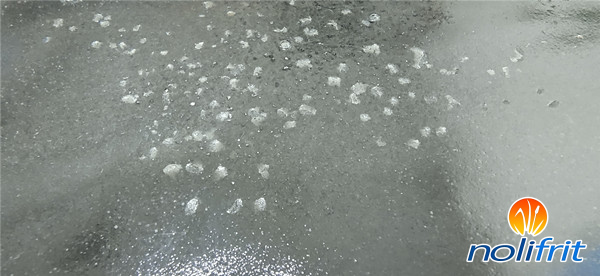Meaning and Cause Analysis of Enamel Fish Scale
The fish scale of enamel is the defect of enamel peeling off. The peeling is often very small flakes of different sizes, and the scars left on the porcelain surface can reach several millimeters, and sometimes they are as small as tiny crystal spots. This is called "Crystalline Fish Scale". It is the most troubling and common enamel defect in the enamelling process. Sometimes it will appear on the vessel immediately after the ground coat is fired, and it will also appear during storage and use (delayed fish scale). And because fish scale often appear in accidents and disappear after a period of time when the production process has not been changed. Therefore, many analyzes have been done on the causes and solutions of fish scale.

The main reason for the formation of fish scale is that under the pressure of molecular hydrogen, the enamel layer is cracked from the metal. At high temperature, steel absorbs hydrogen in the form of atoms and dissolves in the metal. The degree of solubility depends on the structure of the steel. Therefore, impurities contained in steel also play an important role, such as sulfur, phosphorus, and silicon. Impurities such as aluminum and arsenic, as well as hydrogen hydrides (Hydride), help steel absorb hydrogen. Once the temperature drops to room temperature, the solubility of hydrogen decreases by a factor of 1000. At the junction of metal and enamel, hydrogen is gaseous and dispersed and concentrated at the defect of the structure. The pressures that occur are as high as 110 atmospheres, resulting in weak bonds and metal defects that fracture the enamel from the metal. Coupled with the strain in the enamel layer, a large difference develops in the thermal expansion coefficients of the metal and the enamel, which causes the hydrogen pressure to cause flakes on the enamel surface. The higher the Compressive Strain (that is, the lower the expansion coefficient of the enamel), the greater the tension of the small flakes of the enamel parallel to the surface. When the ground coat is under tension, the fish scales burst and the enamel surface has a large angle. , will show "microcrystalline" scales.
If the hydrogen pressure is high, the ground coat vessel after firing will immediately show fish scale once it cools down. If the hydrogen pressure is a little lower, the fish scale will not appear immediately. After the topcoat has been applied (rapid heating during drying and firing) causes the hydrogen pressure to build up, producing fish scale bursts. Sometimes when the enamel ground coat is softened in the furnace, hydrogen is precipitated to form a second boil or bubble. From the surface, it looks like the fish scales formed on the porcelain surface burst, but in fact this kind of crack usually originates from the metal surface, or from the bubbles or cracks of the ground coat, which has penetrated into the metal.
In addition to the cause of fish scale, hydrogen may also be caused by the high content of C, S, P, and Si elements in the thin steel plate; high acid concentration, long pickling time; poor clay quality, many impurities; high furnace temperature, partial burnt ground coat coke. For this, please refer to the following solutions:
1. Select a suitable high-quality steel plate for enamel;
2. The acid concentration should not be too high, and the pickling time should be appropriate;
3. Choose high-quality clay;
4. Use hard and soft mixed ground coat, grind and add about 10% calcined quartz, and the firing furnace temperature of the ground coat should not be too high to avoid local burning.